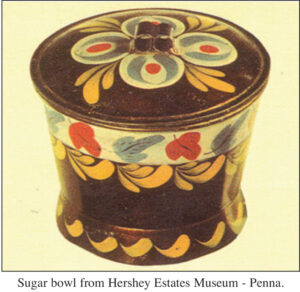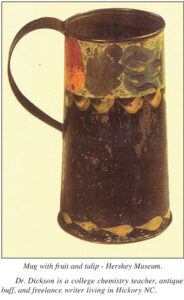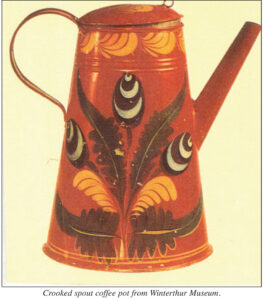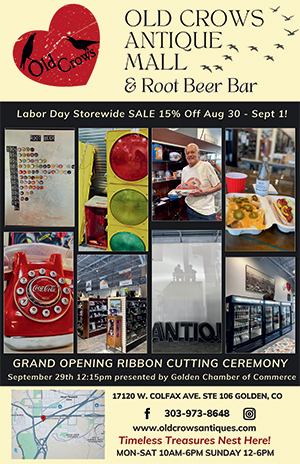 By Charles Dickson, Ph.D.
By Charles Dickson, Ph.D.
During most of the 20th century those who collected antiques of metal concentrated on items made of iron, brass, copper, silver or pewter. They generally overlooked what they regarded as cheap country tinware. But this has begun to change and collectors are realizing the value of American country tinware produced from the 18th to the early 20th centuries.
One attraction for these items, which included coffee pots, deed boxes, trays, bread plates, teapots and syrup jigs, was the fact that they could be varnished and decorated with oils to make a handsome display.
The early pieces were unpainted, but decorated tinware began in the 19th century. Some early items came from England, but eventually American manufacturers arose around 1830. The process for making tinware was relatively easy requiring only wooden mallets, tin shears, chisels and a soldering iron. Working on a wooden bench the tinsmith could use a charcoal brazier to heat his soldering iron and melt the solder. The American tinware industry started in the 1830s and some of these products can still be found at estate auctions and in attics. Of course, antique shops have such materials, but usually at much higher prices.
 Perhaps the best resources for those interested in studying and collecting tinware are in the state of Massachusetts. These resources include such obvious places as Old Deerfield and Old Sturbridge Village, but there are also exhibits at the Whaling Museum at New Bed- ford and the Indian Museum and Shaker Cottage at Harvard Village. Of course, the state has many excellent antique shops where you can find tinware.
Perhaps the best resources for those interested in studying and collecting tinware are in the state of Massachusetts. These resources include such obvious places as Old Deerfield and Old Sturbridge Village, but there are also exhibits at the Whaling Museum at New Bed- ford and the Indian Museum and Shaker Cottage at Harvard Village. Of course, the state has many excellent antique shops where you can find tinware.
Second only to Massachusetts is Connecticut which was the home of many apprentices who trained in Europe. Bloomfield, Hartford, and Southington are prime areas for your search. The state of Maine had a vibrant tinsmithing trade that produced items of distinct shapes and colors. The knowledgeable collector can spot such differences as angles of the teapot spout and dis- tinctive yellow and black colors which dominate their tinware.
From its New England roots the tin industry would spread to New York and Vermont. The Shaker Museum at Chatham and the Rochester Museum of Arts and Sciences are exceptional sites in New York as is the Museum of the New York State Historical Association in Cooperstown. The Shelburne Museum beside Lake Champlain in Vermont is a great resource for that area.
Further west, tinsmithing became abun- dant, particularly in Pennsylvania. The Philadelphia Museum of Fine Arts and the State Museums at Harrisburg, Sunbury and Landis Valley have excellent collections of early tinware, as does the Winterthur Museum in Wilmington, Delaware.
 If you collect tinware, you should know it can be found in just about every corner of the United States, but the availability increases greatly when you do your searching in the northeast quadrant of the country.
If you collect tinware, you should know it can be found in just about every corner of the United States, but the availability increases greatly when you do your searching in the northeast quadrant of the country.
Since much of the really old tinware is prized, collectors will want to know what steps they can take to insure the safekeeping and continued value of their collection.
Here are a few helpful hints for maintaining the value of the tinware items in your collection:
1. Do not rub hard to clean them since some of the fine brush strokes may be rubbed off if there was no varnish applied by the maker to protect it.
2. You need to clean the pieces very carefully with light strokes using nothing stronger than mild soap and lukewarm water.
3. In order to seal the artwork you may want to apply a thin coat of clear high-grade varnish. Some collectors prefer using a coat of wax rather than varnish.
4. As time goes on you should keep the pieces waxed or polished using a good furniture polish.
Finally, remember that your tinware has been around for a long time. With some tender loving care, it can last a lot longer.
Good luck in your searches.













Follow Us